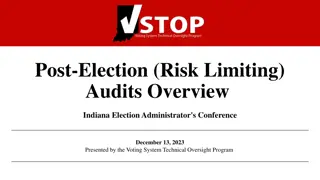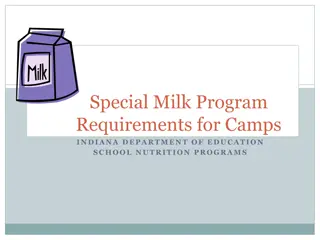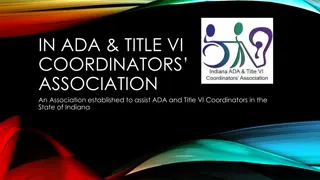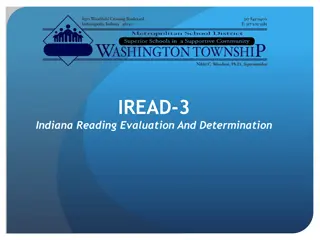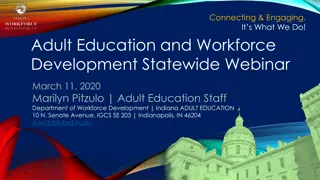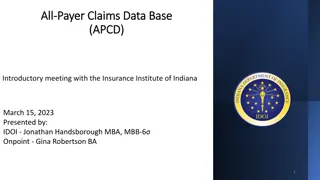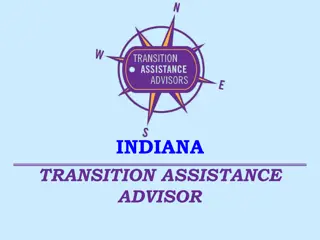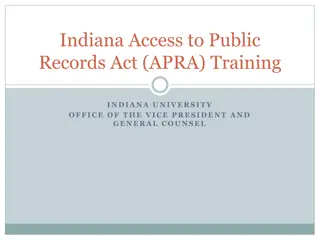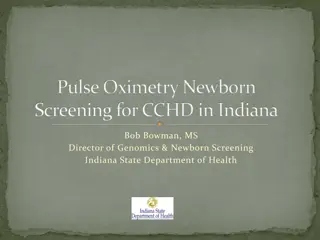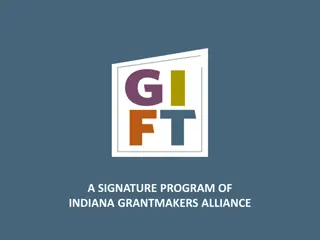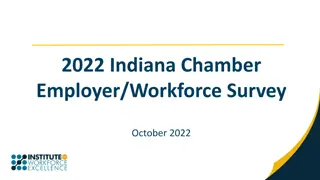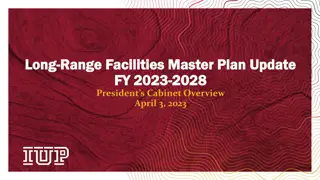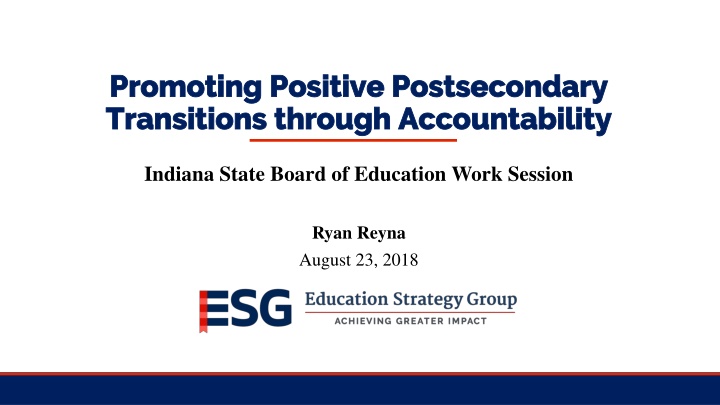
Promoting Positive Postsecondary Transitions through Accountability: Indiana State Board of Education Work Session
Explore the initiatives undertaken by the Indiana State Board of Education to enhance postsecondary transitions through accountability measures and effective strategies discussed in the work session led by Ryan Reyna on August 23, 2018.
Download Presentation

Please find below an Image/Link to download the presentation.
The content on the website is provided AS IS for your information and personal use only. It may not be sold, licensed, or shared on other websites without obtaining consent from the author. If you encounter any issues during the download, it is possible that the publisher has removed the file from their server.
You are allowed to download the files provided on this website for personal or commercial use, subject to the condition that they are used lawfully. All files are the property of their respective owners.
The content on the website is provided AS IS for your information and personal use only. It may not be sold, licensed, or shared on other websites without obtaining consent from the author.
E N D
Presentation Transcript
Promoting Positive Postsecondary Promoting Positive Postsecondary Transitions through Accountability Transitions through Accountability Indiana State Board of Education Work Session Ryan Reyna August 23, 2018
Agenda Agenda Reflections from research and experience Components of a strong CCR measurement Approaches to prioritization Review of measures Other issues to consider 2
Lessons learned about Lessons learned about multiple measure multiple measure accountability systems accountability systems 3
Reflections from research and experience Reflections from research and experience Link measures to goals How does each measure help IN meet its postsecondary attainment goal? Measures should be Meaningful Objective and research-based Actionable Limited There are multiple components of an accountability system Big A accountability Little a accountability and reward This is a process and can/should evolve over time 4
K K- -12 is increasingly 12 is increasingly prioritizing college and prioritizing college and career readiness career readiness 5
2012 2012 WA ME MT ND MN OR NH VT ID NY SD WI MA RI MI WY PA IA CT NJ NE OH NV IN IL UT DE MD WV CO CA VA KS MO KY NC TN OK AZ SC NM AR GA AL MS LA TX FL AK HI 6
2015 2015 WA ME MT ND MN OR NH VT ID NY SD WI MA RI MI WY PA IA CT NJ NE OH NV IN IL UT DE MD WV CO CA VA KS MO KY NC TN OK AZ SC NM AR GA AL MS LA TX FL AK HI 7
2018 2018 WA ME MT ND MN OR NH VT ID NY SD WI MA RI MI WY PA IA CT NJ NE OH NV IN IL UT DE MD WV CO CA VA KS MO KY NC TN OK AZ SC NM AR GA AL MS LA TX FL AK HI 8
What makes a strong What makes a strong college college- - and career and career- -ready accountability system? accountability system? ready 9
Destination Known Destination Known Provides a roadmap for the measures and strategies states can use in an accountability system to support all students in reaching their destination: success after high school. It s a matter of equity, as fewer youth from traditionally underserved subgroups transition to and successfully complete postsecondary education and training.
Four Categories for States to Measure College and Four Categories for States to Measure College and Career Readiness Career Readiness 11
MEASUREMENT CATEGORY 1: MEASUREMENT CATEGORY 1: Progress Toward Post Progress Toward Post- -High School Credential High School Credential MEASURE: Successful progress toward credential of value beyond high school PLUS: Attainment of 1+ postsecondary credits while in high school Exceptional PLUS: Completion of a state-defined pathway of 3 or more credits that is aligned to the student s academic and career plans Advanced Completion of state defined college- and career-ready course of study Fundamental 12
MEASUREMENT CATEGORY 2: MEASUREMENT CATEGORY 2: Co Co- -Curricular Learning and Leadership Experiences Curricular Learning and Leadership Experiences MEASURE: Successfully completed a co-curricular experience aligned to their identified interests PLUS: Third-party evaluation that student met expectations and demonstrated gain of academic, technical and/or professional skills Exceptional PLUS: Alignment between student s academic and career plans and Learning and Leadership experience Advanced Completion of a state-defined co-curricular Learning and Leadership experience* Fundamental * Learning and leadership experiences include extended work-based learning (such as pre- apprenticeship program or internship), service learning or co-curricular activity 13
MEASUREMENT CATEGORY 3: MEASUREMENT CATEGORY 3: Assessment of Readiness Assessment of Readiness MEASURE: Scored at the college- and career-ready level PLUS: Performance-based demonstration of professional skills within an academic or technical context (e.g., capstone) Exceptional PLUS: Completion of a pathway-aligned assessment or demonstration of technical skills (e.g., AP, IB, IRC) Advanced Attainment of state-defined college- and career-ready level on high school summative assessment Fundamental 14
MEASUREMENT CATEGORY 4: MEASUREMENT CATEGORY 4: Transitions beyond High School Transitions beyond High School MEASURE: Successfully transitioned to postsecondary or the workforce within 12 months of graduation Enlistment in military, enrollment in certificate or registered apprenticeship program, or employment in a field identified in the state s WIOA plan Exceptional Enrollment in IHE without remediation or employment at a state-defined wage threshold Advanced Enrollment in 2- or 4-year institute of higher education (IHE) or postsecondary training Fundamental 15
Approaches for prioritizing Approaches for prioritizing key measures key measures 16
Within formal accountability system Within formal accountability system Approaches Discussion Measures Separate Metaindicator Weight Calculation Distance to goal Adjusted performance Status or improvement Bonus points What is the appropriate balance between simplicity and accuracy? Will the measure(s) actually matter given the weights? Are there measures that should come off the table? What is the process/timeline for transition to new indicators? 17
Beyond formal accountability system Beyond formal accountability system Approaches Discussion Report School report card College Readiness report Challenge Internal External Reward Create award Highlight in communications Facilitate sharing best practices How can the state leverage its school report card redesign to prioritize specific measures? How can the state further promote CHE s College Readiness report? What opportunities exist to engage school and district administrators in conversations about the data? How can the state promote success and improvement? 18
Discussion of key measures Discussion of key measures beyond the current beyond the current accountability system accountability system 19
What else can be measured? What else can be measured? 1. What happens to students after they leave high school? 2. What steps are students taking to prepare for college and career throughout K-12? 3. What climate exists to support students on their path to college and career readiness? 20
Postsecondary transitions Postsecondary transitions Measure Postsec enrollment Connected to attainment goal & data are available Postsec enrollment without remediation preparation for success Benefit Challenge May not signify readiness Example CT, CO & MO GA Powerful indicator of student Definitions of remediation change & out-of-state data not generally available Data access Registered Apprenticeship Combination of education and training leading to employment Engagement in labor market NA Employment (at $X wage level) Military enlistment Summer melt Data access VT Service and employment Large transition hurdle Data access Data access NA NA 21
Key Questions Key Questions To what extent are all postsecondary transitions equal ? What data are available and can the state make cross-sector matches? Given that these measures are lagged, what is the appropriate response for high schools? To what extent would the state want/need to measure performance based on starting point for these metrics? What are appropriate wage level(s)? And after what amount of time 6 months, 1 year, etc.? 22
Transition preparation Transition preparation Measure College and career plans 8th grade credit accumulation 9th grade on-track to graduation FAFSA Benefit Connects learning and activities Prepared for promotion Challenge Measurement of use Example PA & AZ May not offer new insight LA Research-backed predictor Measurement definition IL & DE Predictor of postsec enrollment Clear set of postsec preparation activities Complexity of completing form Communication that not just for program applicants LA - reporting NA College scholar activities 23
Key questions Key questions How can the state encourage preparation prior to senior year of high school? To what extent should measurement begin prior to high school? To what extent / how would these measures interact with Graduation Pathways requirements? How can the state leverage high-impact strategies to prepare students for life beyond high school? To what extent should that be through the formal or informal accountability system? 24
Climate Climate Measure Climate survey Student SEL survey Science / Social Studies Access to well- rounded education* Benefit Conditions of learning Complement to academic preparation Prioritizing courses beyond ELA/math Prioritize activities/courses beyond core coursework Challenge Data access and gaming Data access and gaming Example NM & NV CA CORE Many Limited grades Measurement and data access LA & KY * Interests & Opportunities (LA): schools select from a menu of state-defined options in the following areas: visual and performing arts; world languages; health and fitness; technology and engineering; and, life skills and career preparation. Specific measures are still in development 25
Key questions Key questions What level of reliability/validity is necessary to include a measure? To what extent should a student s experience in school in terms of both climate and access be considered in an accountability system? What other areas beyond core content (ELA and math) are priorities for the state? To what extent do these measures need to be paired with other measures to provide a complete picture of school quality ? 26
Issues to consider Issues to consider 27
Key questions Key questions If the state chooses to add additional measures in the future, what is an appropriate timeline and how best to signal that? To what extent should any new measures be included in the formal accountability calculations versus public reporting or reward? How will data access and quality affect or be affected by the answer? To what extent should any new measures be based on improvement over time (or take into account starting point)? What is an appropriate way to measure success ? 28
Thank You Thank You Ryan Reyna rreyna@edstrategy.org @RyanEReyna 29
Resources Resources Destination Known: Valuing College and Career Readiness in State Accountability Systems Mapping Career Readiness in ESSA Shining a Spotlight on K-12 and Higher Education Alignment Aligning K-12 and Postsecondary Credential Attainment Goals to Support Success for All Students Strategies to Support Students K-12 to Postsecondary Transitions 30




